Fashion Buyer Prospecting: Tips That Actually Work
Finding the right retail buyers is a challenge, but with the right strategy you can succeed in wholesale. This guide covers key prospecting tactics such as identifying aligned buyers to optimizing outreach, meaning you can build strong, long-term wholesale partnerships.

Prospecting to Buyers at Glance
Connecting with the right fashion buyers requires a strategic approach, as traditional outreach methods often fall short, leading to low engagement and missed opportunities.
To address this, brands are encouraged to adopt smarter strategies that include:
Targeted Prospecting: Identifying buyers whose brand aesthetics and values align with their own.
Data-driven Strategy: Using insights to personalize outreach and stand out against competitors.
Relationship Building: Building and nurturing long-term relationships rather than focusing solely on one-time sales.
Tech-enabled Tools: Utilizing b2b platforms that provide connection opportunities to streamline the prospecting process.
Strategic Timing: Reaching out when buyers are actively searching for new collections.
The Fashion Buyer Landscape Today
Finding the right retail buyers for your brand has become one of the biggest challenges in the industry. The retail world has dramatically changed, with customers craving experiences over simple transactions. Independent retailers are grabbing bigger pieces of the market share, and the online competition between brands has never been stronger.
If you're scaling your fashion wholesale business, you know the struggle. Finding top tier buyers for your brand can feel like searching for that proverbial needle in a haystack. You send emails that disappear into the void of overflowing inboxes. You list your products on generic marketplaces only to see disappointing engagement rates.
The reality? Buyers are drowning in brand pitches. Having great lines and products aren’t enough anymore - you need a smarter way to get noticed by the right people at exactly the right time.
Why Finding the Right Buyers Can Be So Challenging

You're not alone if you're struggling to expand your distribution. Many fashion brands simply don't know where to find buyers who truly match their brand DNA. Others struggle to determine which B2B marketplaces are worth their time and investment.
Even after identifying potential buyers, maintaining consistent outreach becomes a major hurdle. And perhaps most frustrating of all is the challenge of converting one-time orders into lasting retail partnerships.
If these challenges resonate with your prospecting processes, you're in good company. The good news? There's a clear path forward. Let's explore how you can implement our top recommended tips to elevate your buyer prospecting strategy and achieve better wholesale results.
Tip 1: Do Strategic Research and Identify Your Ideal Buyers

Successful prospecting starts with knowing exactly who you're looking for. Before you send your first email or make a call, you need to identify which buyers are well aligned and more likely to become a loyal retail customer.
This foundational step saves you countless hours of fruitless outreach and positions you for partnerships that truly benefit both of you.
Find Aligned Buyers
The truth is - not all retailers are right for your brand. The best partnerships come down to the natural alignment between your offerings and a retailer's price points, aesthetics, and customer base.
Before firing off communication to potential prospects, do your homework. Visit their physical stores if possible. Spend time on their e-commerce platforms. Would your pieces fit seamlessly with what they already carry? Does their visual merchandising style complement your brand's look and feel? Would their customers buy your products?
Remember that forcing a partnership with a misaligned retailer often ends in disappointment for everyone involved. Taking the time to assess compatibility saves everyone valuable time and resources.
Develop Ideal Buyer Profiles
Be specific about who your ideal retail partners are. Map out your ideal buyer personas:
- Who are they? Boutique owners, department store buyers, or online multi-brand retailers?
- What retail categories and price points do they typically work with? Are they in your bracket?
- How much do they usually order from new brands? Can you meet their volume needs?
- Do they share your values around sustainability or ethical production?
- What payment terms might they expect? Can your cash flow handle their typical terms?
- What collaboration patterns have they established with similar brands? Do they tend to stick with brands season after season?
Doing the practical groundwork from the get-go will save you from wasting time on poor-fit prospects. Tools like JOOR Discover make this process easier by letting you filter through vetted directories to find buyers who match your specific criteria.
Credible online resources can help you identify retailers whose business models and customer bases align with what your brand offers, significantly narrowing your focus to the most promising opportunities.
Research Buyer Habits Before Pitching
Knowing about potential stockists’ stores is not enough; you should always take the time to learn about the buying cycles of the retailers you want to target, as well as their seasonal budget timelines and preferred methods of communication. Knowing this information will help you to align your outreach with buyers' budget-setting periods and contact preferences.
Tip 2: Make Use of Effective Outreach Techniques

Once you've identified your ideal buyers, how you approach them makes all the difference. Buyers are inundated with brand pitches daily, so generic outreach simply won't cut through the noise.
Here are some proven tactics that can help your brand stand out and make a memorable impression, combining both in-person and digital approaches for maximum impact.
Tactics for Physical Prospecting
Don't underestimate the power of something tangible in an overwhelmingly digital world. When a buyer can touch your fabric swatches, get glimpses of next season’s collection, or flip through your beautifully designed lookbook, you create a physical reminder of your brand that's much harder to ignore than another email.
Try this three-contact approach:
- Step One: Send something from your collection they can touch and experience. A package with fabric swatches and a short, handwritten note about why you think they'd be perfect for your brand. Include a tailored lookbook that showcases your collection in a way that speaks to their specific store aesthetic. These tangible touch points significantly increase customer conversion rates when you follow up later.
- Step Two: Follow up with a call. Wait about a week, then call to confirm they received your package and gauge their initial reaction while it's still fresh in their mind. This timing is crucial. If it’s too soon, they may not have had time to review your materials. If it’s too late, then the impact diminishes.
- Step Three: Finally, email the buyer with your value proposition. Send a personalized message that builds on your conversation and outlines exactly how to move forward if they're interested. Summarize your value proposition concisely and make the path to working together clear.
Optimize Your Digital Outreach
Your digital outreach needs to be just as thoughtful as your physical strategy. Jump into virtual fashion weeks and trend forecasting webinars where serious retail professionals gather. Engage with attendees in the chat, ask insightful questions, and follow up personally with connections you make.
When you reach out directly on LinkedIn, make it hyper-personal. Notice they just opened a new location? Mention it. Did they just celebrate a store anniversary? Acknowledge it. Have they recently posted about sustainability initiatives? Connect that to your brand's practices. Generic messages scream "mass mails" and get ignored, but referencing specific buyer milestones shows you've done your homework.
For your email correspondence with prospects, it’s helpful to do the following:
- Craft subject lines that intrigue without sounding spammy.
- Keep your attachments small enough not to crash their inbox.
- Write like you're talking to a colleague, not delivering a sales pitch - conversational but still professional.
- Avoid trigger words that might send your carefully crafted message straight to the spam folder, and make sure your tone strikes the right balance between friendly and business appropriate.
Use Influencer Marketing to Build Buyer Confidence
Buyers often validate new brands by checking for social proof online. Showcasing your influencer partnerships can signal your credibility to retailers and make them more likely to trust in your product. When contacting prospects, be sure to include your influencer campaign results, media features, and viral social content in your outreach decks for the best chance of success.
Tip 3: Leverage Professional Networks and Industry Events
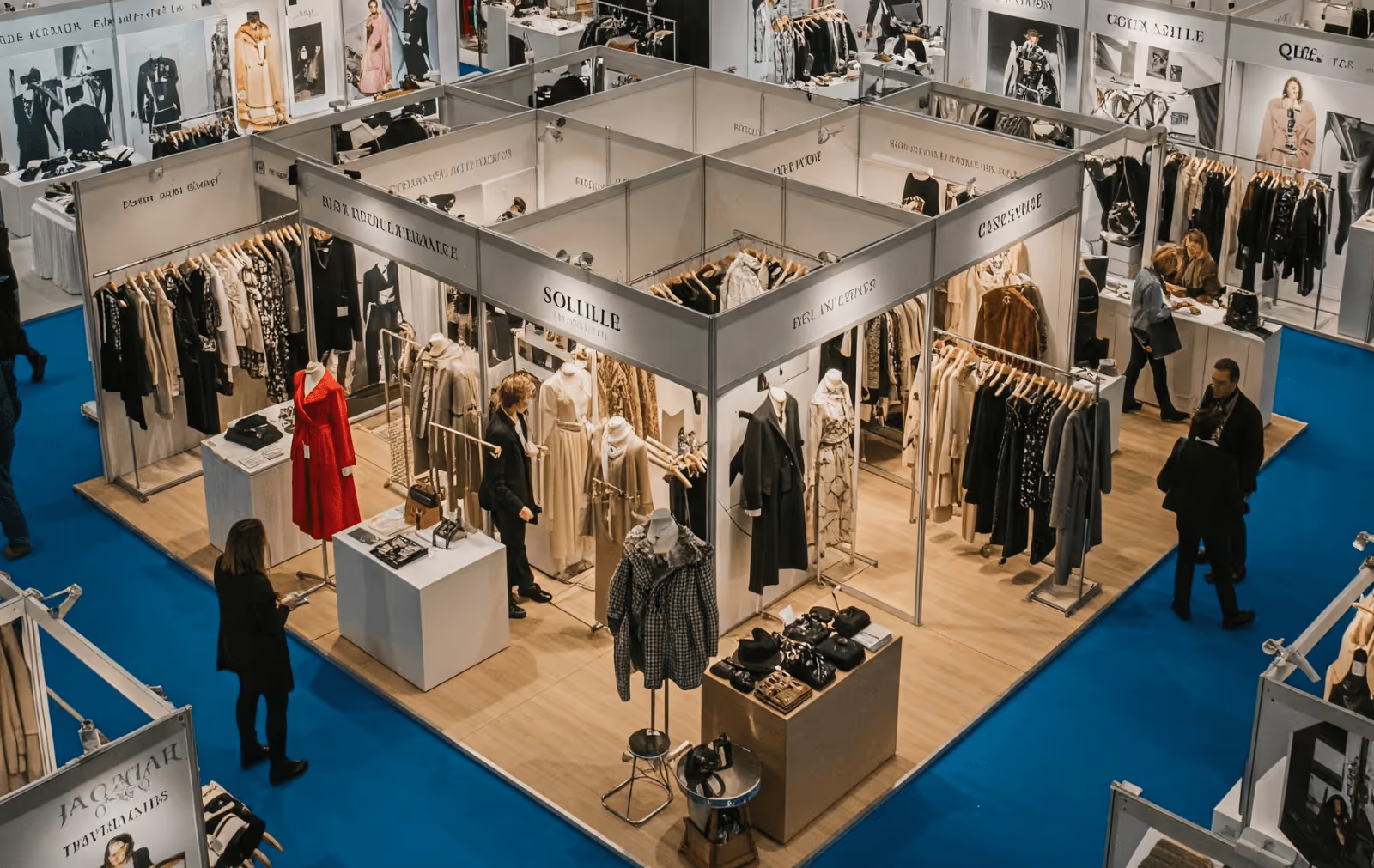
Wholesale fashion runs on relationships, and some of the most valuable connections happen during industry gatherings. With the right approach, these events become your most powerful prospecting tool.
Prospecting at Trade Shows
Trade shows remain incredibly important for meeting buyers face-to-face. It’s important that you don't just show up and hope for the best. Map out which shows truly align with your brand position and offering. Start with regional shows before investing in expensive international exhibitions.
Before you even pack your sample collection, do your homework. Which buyers from your target list will be there? Can you pre-schedule meetings with your targeted retailers? Having these appointments locked in helps shift your trade event experience from anxious booth-manning to productive relationship-building.
Post show, be careful of generic "Nice to meet you" emails. Reference specific conversations: "You mentioned loving our sustainable denim line, here's more information about our manufacturing process that I promised to send." This personalized follow-up bridges the gap between a pleasant meeting and an actual business relationship.
Engage in Online Communities
When it comes to expanding your presence online, ask yourself, “Where and how do fashion buyers consume their content digitally?” Look for active wholesale fashion Reddit forums, LinkedIn groups, and industry-specific platforms where buyers exchange ideas.
By understanding where your target buyers spend their online time, you can strategically position your brand in these spaces.
Be careful to immediately start pitching your brand. Instead, begin by sharing genuinely helpful insights relevant to your market segment. Comment thoughtfully on industry trends and answer questions within your expertise. This helps establish yourself as someone who adds value first, sells second.
Engaging in meaningful conversations builds your reputation as a knowledgeable industry partner rather than just another brand looking for shelf space.
We've found that brands using structured outreach tools have a 9x higher success rate in securing buyer relationships compared to those using scattered, ad-hoc approaches.
Follow Up Quickly After Trade Shows
Buyers meet dozens of brands at shows, so to stay at the forefront of their minds, timing is everything. Reach out the day after a trade show and ask if they have any further questions or if you can assist with order placement in any way.
Be sure to let them know how much you enjoyed meeting and look forward to working together. Conveying this message early keeps the momentum going; a delayed follow-up is much less likely to get a response.
Tip 4: Craft Compelling Sales Materials

Even the most promising buyer connections won't convert without professional, persuasive sales materials. Your lookbook and line sheets are sales tools that should work as hard as you do, if not more.
Meticulously Develop Your Lookbook
Your lookbook is more than just a pretty portfolio highlighting your collections, it's a critical device that balances vision with commercial practicality to move buyers from interest to action. Yes, your photography should be captivating, but buyers also need the nitty-gritty details that help them make purchasing decisions.
For maximum impact, customize sections of your lookbook for specific buyers where and when possible. Highlight the pieces that would work especially well with their existing inventory or customer base. Being bespoke in your approach shows that you've taken the time to understand their business and aren't just sending generic materials to everyone on your contact list.
Don't make buyers hunt for essential information. List detailed fabric composition and care instructions so buyers can confidently answer customer questions. Be completely transparent about your pricing structure - whether you offer per-unit pricing or tiered discounts for larger orders.
The most effective lookbooks find that sweet spot between visual inspiration and commercial transparency. They tell your brand story while simultaneously addressing the practical questions buyers might have about adding a new line to their assortment.
Optimize Your Line Sheets
Gone are the days of static, text-heavy line sheets that put buyers to sleep. Your digital line sheets should leverage technology to create an engaging, informative experience that makes ordering intuitive and efficient.
Use dynamic pricing tools that automatically adjust based on currency and order quantities, so international buyers immediately understand their investment without doing manual calculations. If you offer bulk discounts or tiered pricing, make these options crystal clear so buyers can see the value in placing larger orders.
Make sure your systems talk to each other, too. When a buyer is considering placing an order, they should be able to see live inventory updates and current order quantities. This transparency removes friction from the buying process and builds trust with your retail partners.
Share Case Studies and Testimonials
Buyers want evidence that your brand performs well at retail, so try to gather as many testimonials from your existing partners as possible to reduce perceived risk. Adding retailer success stories to your lookbooks and linesheets, with strong data points to support them, will be the most impressive and give you the best chance of success.
Tip 5: Build Long-Term Relationships

Landing a first order is just the beginning. The real value comes from buyers who return season after season. By thinking beyond the initial sale, you'll create the foundation for sustainable growth.
Build the Trust Factor
The most profitable wholesale relationships develop over multiple seasons, but this doesn't happen by accident. You need to think about the entire relationship journey from day one. Plan for the long-term before you even send your first outreach email.
- What will your post-sale support look like?
- How will you help retailers sell through your products?
- What will make them come back for more?
Trust is the foundation of every good relationship – even with your buyers. Be transparent about your pricing, production timelines, and shipping expectations. Don't overpromise and underdeliver. Show buyers exactly how you'll support them with marketing assets, co-branded content, or in-store materials that can help move the collection.
Demonstrate how you'll actively support retailers through aligned strategies, from brand collaborations to key marketing initiatives that drive foot traffic and sales.
Be Adaptive in Your Communications Strategy
The best brand-retailer relationships are so much more than purely transactional. How can you add value beyond simply selling your collections?
- Share trend forecasting reports that help your buyers plan future inventory.
- Offer sell-through analysis that supports smarter reordering decisions.
- Consider organizing exclusive online trade shows for your key prospects.
Virtual events can create a sense of exclusivity and allow you to provide personalized presentations without the constraints of a physical trade show environment. Buyers appreciate this tailored approach and the opportunity to preview collections before their competitors.
As your wholesale business grows, you'll need systems to help you maintain these personal connections at scale. Smart CRM and automation tools let you deliver personalized communication without dropping the ball on follow-ups. The key is using tech to enhance relationships, not replace the human element that makes them special.
Set up systematic check-ins throughout the season, not just during buying periods. Inquire about sell-through rates, gather feedback on what's working and what could be improved, and use this information to strengthen future collections.
This consistent communication demonstrates your commitment to the retailer's success and keeps your brand top of mind when it's time for the next round of buying.
Protect Your Brand With Contracts
New brands can often face delayed payments, unauthorized discounts and stock returns if they don’t have clear contracts in place. Protect your cash flow and ensure buyers take the partnership seriously by having strong legal support behind all of your wholesale partnerships.
Tip 6: Use Technology to Prospect Smarter

Save yourself time and effort when searching for new wholesale retail connections by using technology to your advantage to speed up the outreach process and make fashion industry networking easier.
CRM Tools for Buyer Tracking
Using CRM tools to monitor your email outreach can help you obtain real-time data on how effective your prospecting process really is.
Study which of your emails has the best open rate and replicate similar subject lines and headers to maximize your success, and take note of which emails don’t perform as well and make any necessary changes. Split potential buyers into different segments depending on their region or preferred communication style for a personalized and highly targeted approach.
LinkedIn Sales Navigator for Targeted Search
If you’re struggling to find contact information for a potential lead, consider using LinkedIn’s Sales Navigator tool for a more targeted search. You can specify exact job titles and organizations that you’d like to connect with to get tailored suggestions that will increase your chances of prospecting success.
Email Automation That Feels Personal
Automated emails can help to greatly speed up the prospecting process, but make sure there is customization in each one to keep a human touch.
Even though you may be sending out upwards of forty emails a day, it's important that each buyer feels like you are reaching out to them personally because you genuinely care about being stocked in their store. Try to insert small details about their store specifically to build a connection.
Common Challenges in Apparel Prospecting

Prospecting is not an easy task, and many brands face challenges as they try to reach out and make connections with retailers.
High Competition
Retailers receive hundreds of emails from brands that want to be stocked in their store every day, and they can easily get fatigued or forget which brand is which as they sift through a sea of emails. Ensure your message stands out from the rest, and don’t be scared to follow up to make sure they’ve read your email and asked any questions they may have.
Fluctuating Buyer Demand
A JOOR survey found that 66% of buyers are actively seeking new brands throughout the year; however, many retailers still follow a traditional seasonal schedule and are not constantly looking throughout the year for newness. Be sure to account for fluctuating buyer demand when you are prospecting.
Inventory and Delivery Pressure
When you are looking to make new wholesale connections, many brands feel pressured to accept large orders they know they cannot fulfil and agree to delivery deadlines they cannot meet in order to secure a sale with a new retailer.
This tactic is dangerous to your business and puts not only your finances but also your brand image in jeopardy, as retailers will see you as unreliable and unable to deliver on your promises.
Pricing Sensitivity
Pricing is something many brands struggle with when trying to secure new wholesale partners. Try to avoid underpricing just to get a sale, as this can signal low quality and limit your profit potential. Also, steer clear of the tactic of overpricing; this is an extremely risky approach and can confuse retailers if you do not have a strong brand identity and a big marketing budget.
Growing Sustainability Demands
Some fashion brands are finding it harder to secure new wholesale stockists due to their lack of sustainable credentials. Consumers, and in turn, retailers are becoming increasingly environmentally conscious, and brands that can meet ethical and eco demands are being favoured. If your brand has no certifications to support its sustainable claims, you may struggle to find new retail connections.
Local vs. Global Buyer Strategy

There are two different strategies brands can take when looking for fashion buyers to prospect to.
Prospecting to Local Buyers:
Targeting local buyers is a tactic that’s often appealing to brands that are new to wholesale, as closer relationships are easier to manage and logistics are often simpler. Reaching out to local stores can be a great way to test new collections without too much risk, as orders are generally smaller.
Prospecting to Global Buyers:
Reaching out to global buyers requires a strong supply chain, consistent quality, and compliance with relevant industry standards and certifications; however, the rewards can be much higher, thanks to much larger orders.
The Power of Inbound Prospecting
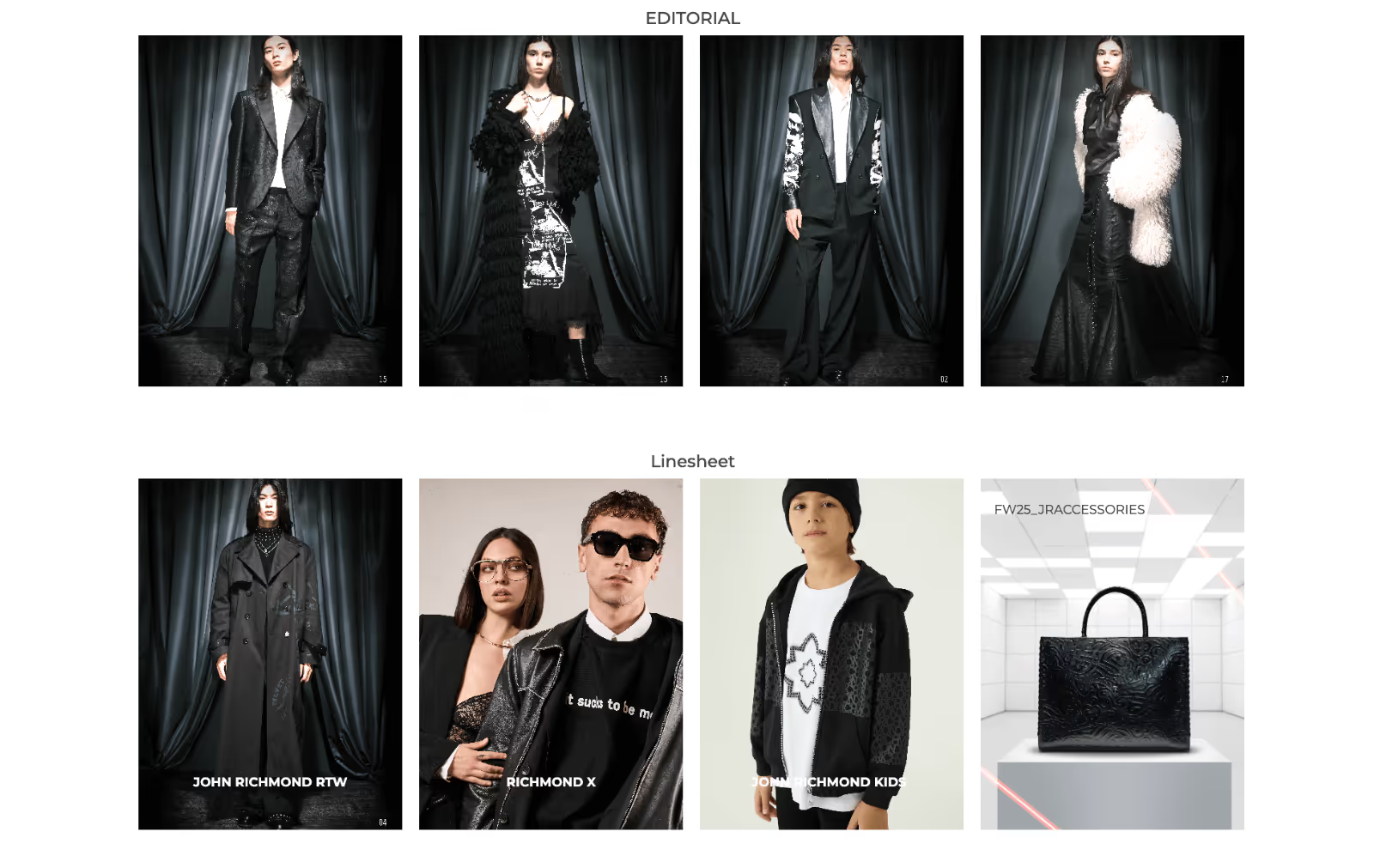
We've focused a lot on outbound strategies, but here's something to give you food for thought - some of your best retail relationships will come from inbound connections (buyers who discover and reach out to you).
Here's how to optimize for inbound discovery:
- Make your online brand profile irresistible. Clearly communicate what makes your brand unique, who your ideal customer is, and why retailers should care.
- Keep everything fresh. Regularly update your collections, lookbooks, and promotional materials so buyers see your latest and greatest work.
- Highlight your values prominently. Increasingly, buyers make decisions based on sustainability practices, ethical production, and a brand’s story.
- Treat inbound inquiries like gold. When a buyer reaches out to you, they're already interested—respond quickly and personally to nurture that initial spark.
By strategically positioning your brand on platforms where buyers actively search for new partners, you create opportunities for those "perfect fit" connections that feel effortless but drive serious business results.
JOOR Discover at a Glance
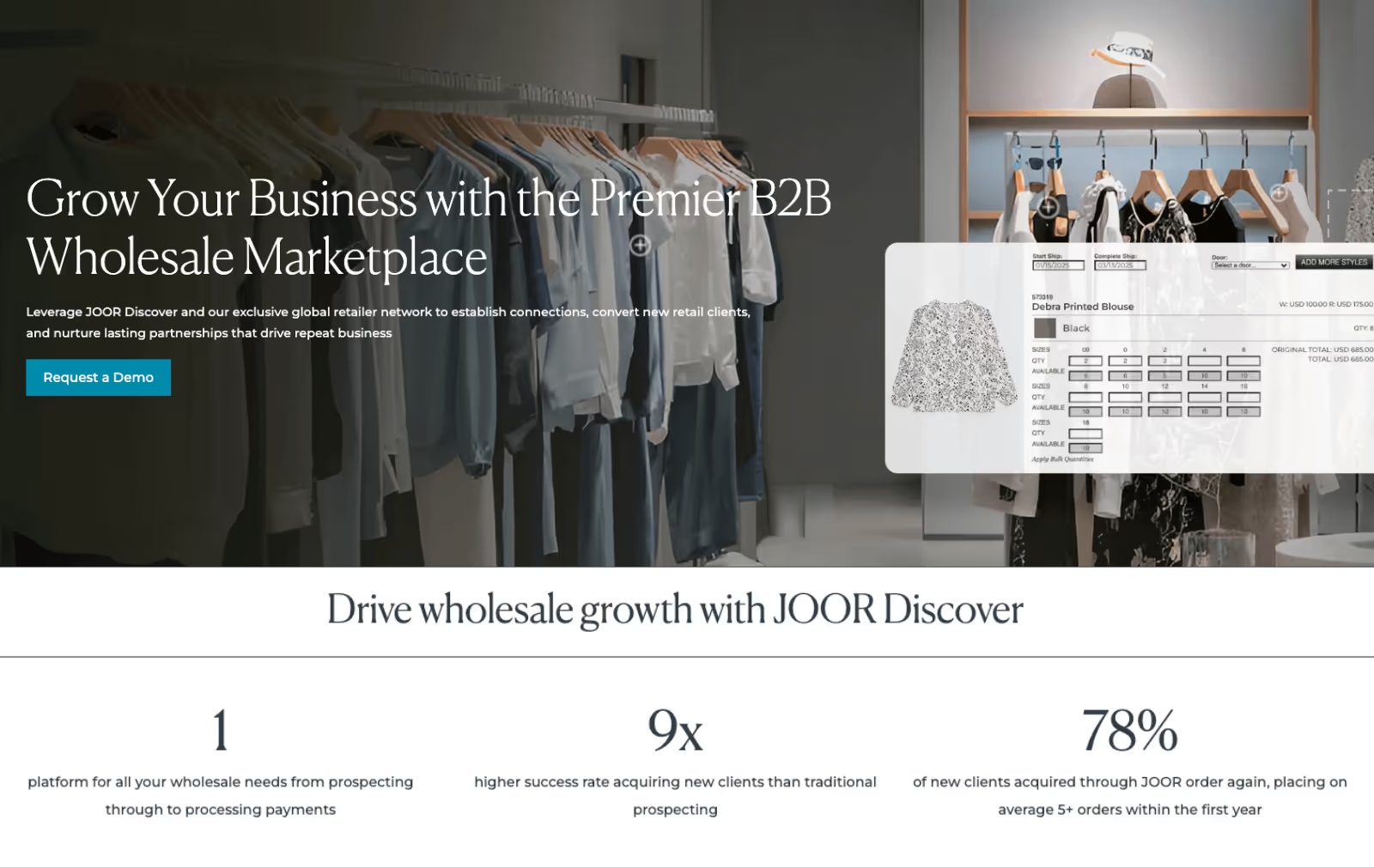
Making wholesale fashion brands more discoverable is exactly why JOOR Discover was designed. The tool helps change the fragmented prospecting process into a streamlined, data-driven approach for both brands and retailers.
Here’s a snapshot of JOOR Discover’s key benefits:
- An exclusive retailer directory featuring qualified, active buyers
- Tools for high-quality, targeted outreach to the right decision-makers
- A centralized prospecting process that eliminates scattered spreadsheets and missed opportunities
- Comprehensive sourcing capabilities built around your brand profile
- A dynamic dashboard providing real-time visibility into outreach performance
- Access to actionable data and reporting that refines your prospecting strategy over time
The results speak for themselves: 78% of brands that connect successfully through JOOR place multiple orders, creating sustained wholesale relationships rather than one-time transactions.
Maximize Your Prospecting Success
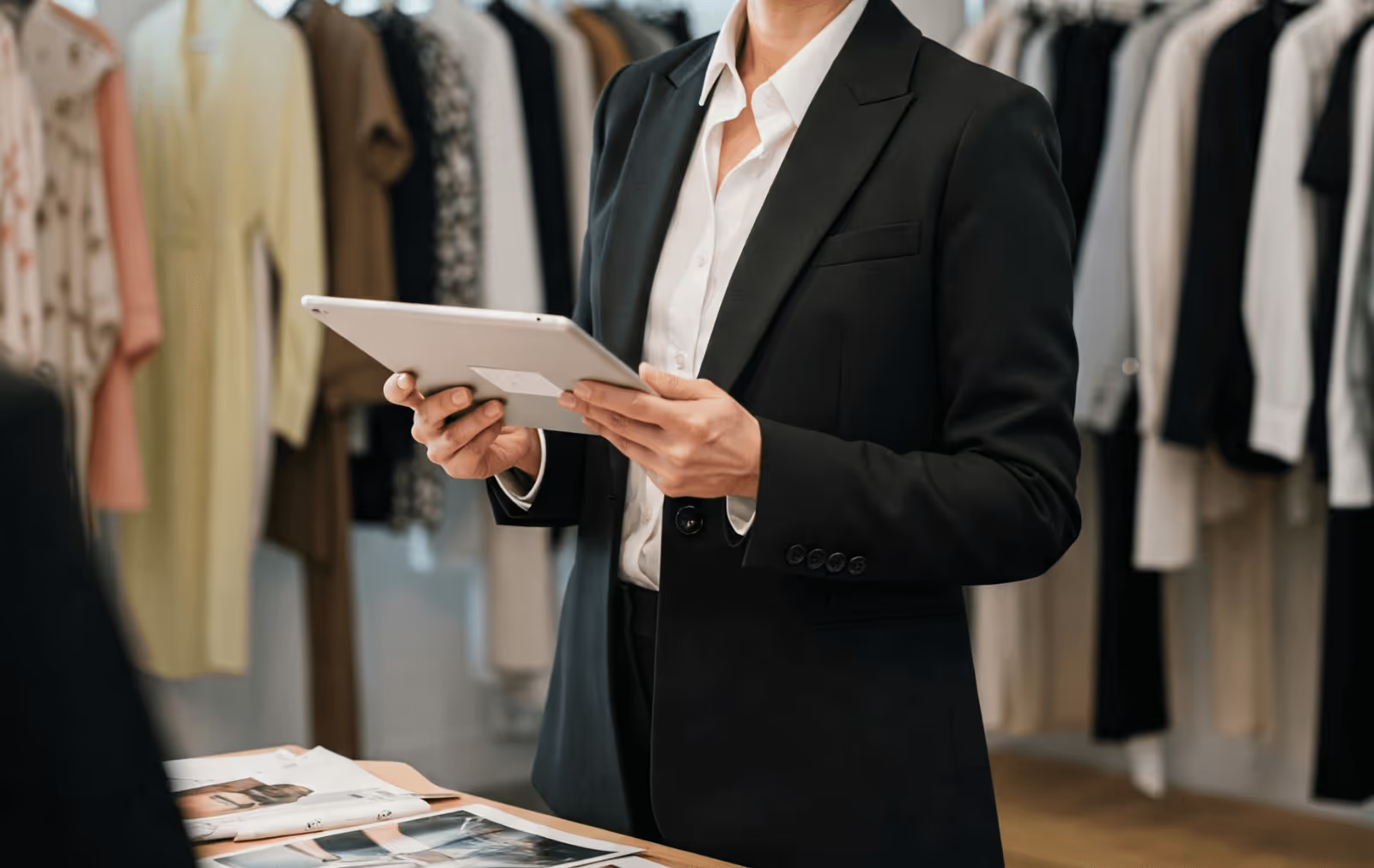
Building strong wholesale relationships starts with connecting with the right retail partners. Successful buyer prospecting is about being strategic, personalized, and consistent in your approach.
By implementing the five key tips we've explored, you can make your buyer prospecting strategy into a refined, results-driven process that supports your brand's unique growth objectives.
Ready to start seeing real results? Request your JOOR demo today and discover how our platform can connect your brand with the right retail partners.
FAQs on Finding Fashion Buyers
How do I find fashion buyers for a new brand?
You can find fashion buyers by attending trade shows, searching on social media or joining a fashion industry B2B network like JOOR.
What do fashion buyers look for when choosing a brand?
Fashion buyers want to do business with brands that have proven sales, an impactful identity and a strong social media presence. They will favour brands whose product offering aligns with their target market, price point and overall store aesthetic.
How many times should I follow up with a buyer?
There are no hard and fast rules regarding how often brands should follow up with buyers, but a few times a week is an appropriate amount of communication to stay fresh in their mind but also allow them time to respond so they don’t feel pressured or forced.
Is it better to contact buyers online or meet them at trade shows?
Brands have success contacting brands both online and in-person. You can message buyers directly on social media, get in touch via a digital trade show, or meet them the traditional way in-person.
What should I include in a lookbook or line sheet?
Lookbooks should include high quality visuals of your collection and convey your overall brand aesthetic. Your linesheet should showcase your collection images, information and pricing in a way that makes it easy for buyers to shop.
How do I know if a buyer is the right fit for my brand?
When deciding if a retailer is the right match for your brand, think about their customer demographic, values, price points and MOQs. You should align on all of these elements.
Related Insights
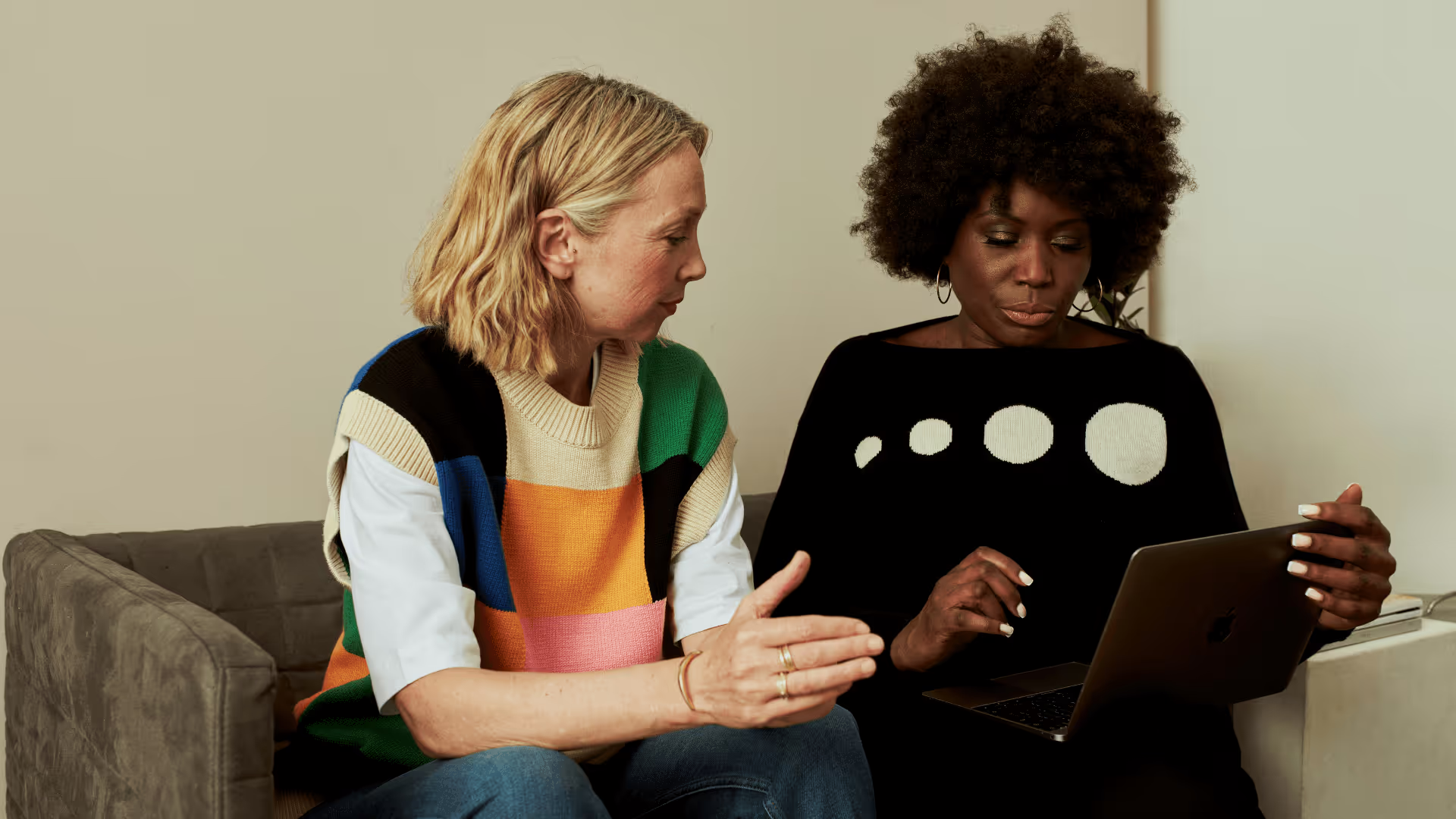
Why Digital B2B Catalogs are Essential for E-Commerce Businesses
Online catalogs have become a crucial component for retailers and their buyers in an evermore tech reliant industry. Read about how these dynamic product libraries act as comprehensive selling solutions that plug into current buying behaviors.
%2520(2)%2520(1).avif)
8 Ways a B2B Fashion Marketplace Solves Wholesale Scaling Challenges
Learn how a B2B fashion marketplace like JOOR helps your wholesale fashion brand overcome scaling challenges. Maximize resources, build retailer relationships, and enhance distribution to drive growth in the global wholesale fashion market.
%2520(1).avif)
Price Sheets Vs Line Sheets in Wholesale Fashion
Explore the key differences between price sheets and line sheets in wholesale fashion. Optimize product showcasing and sales strategies with clear pricing details and captivating visuals. Enhance buyer experience and streamline ordering process effectively.
.avif)
How to Get Your Clothing Brand in Stores
Intrigued about getting your clothing brand in stores? Discover expert strategies to elevate your brand presence and secure wholesale deals.
.avif)
How Wholesale B2B Marketplaces Help Fashion Brands Find Buyers
Learn the benefits of utilizing a b2b wholesale marketplace that isn't just about transcations, but building lasting relationships and repeat business. Understand more about how b2b fashion marketplaces can help brands looking to scale and build new networks of buyers and connections in other markets.

The Power of Brand-Retailer Partnerships
Learn how brand-retailer partnerships can be a powerful tool to help drive your fashion company's growth. This guide also details the key elements to consider before engaging in a partnership, and how you can go about making new connections.


